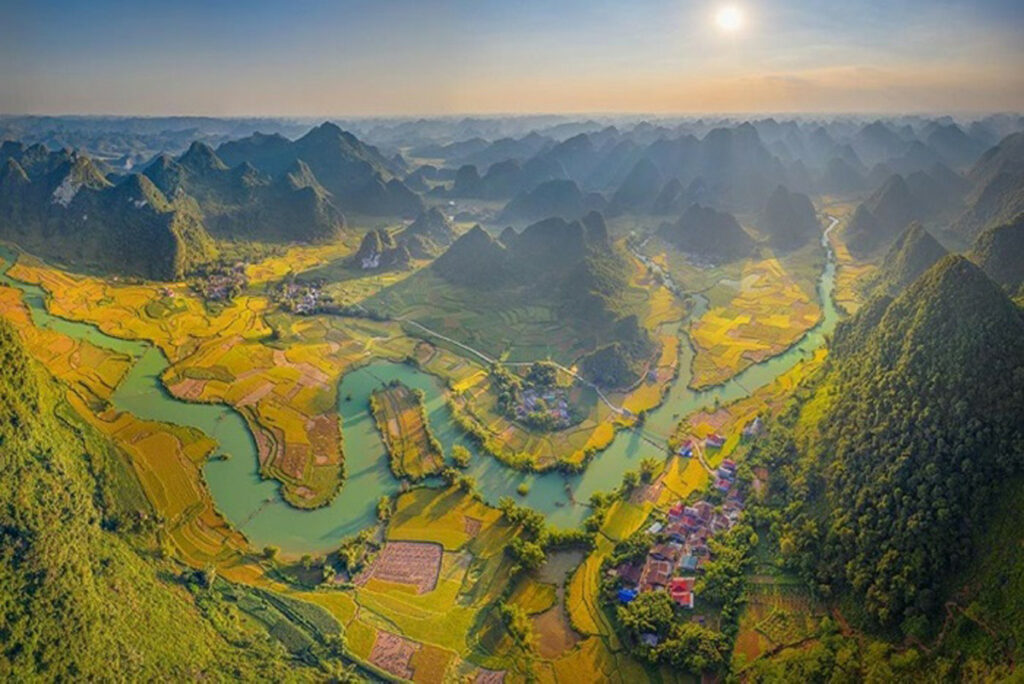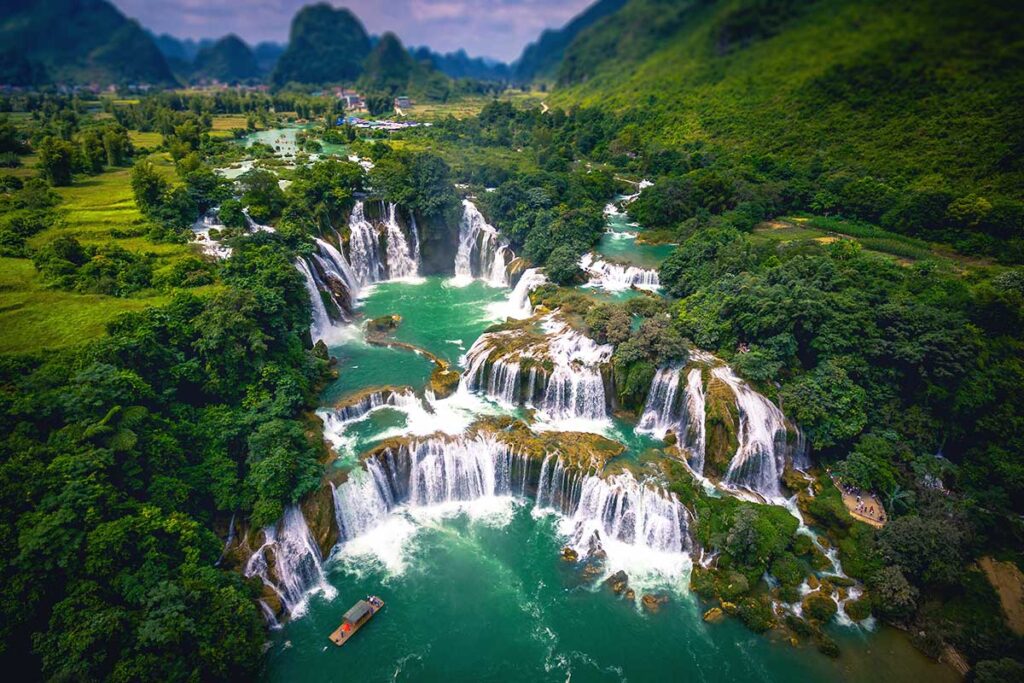Cao Bang: Remote valleys, Ethnic villages and Wild scenery
Cao Bang is a mountainous province in northern Vietnam, right along the border with China. While most people know it for Ban Gioc — the most impressive waterfall in Vietnam — the province is packed with untouched landscapes that remain far off the tourist trail.
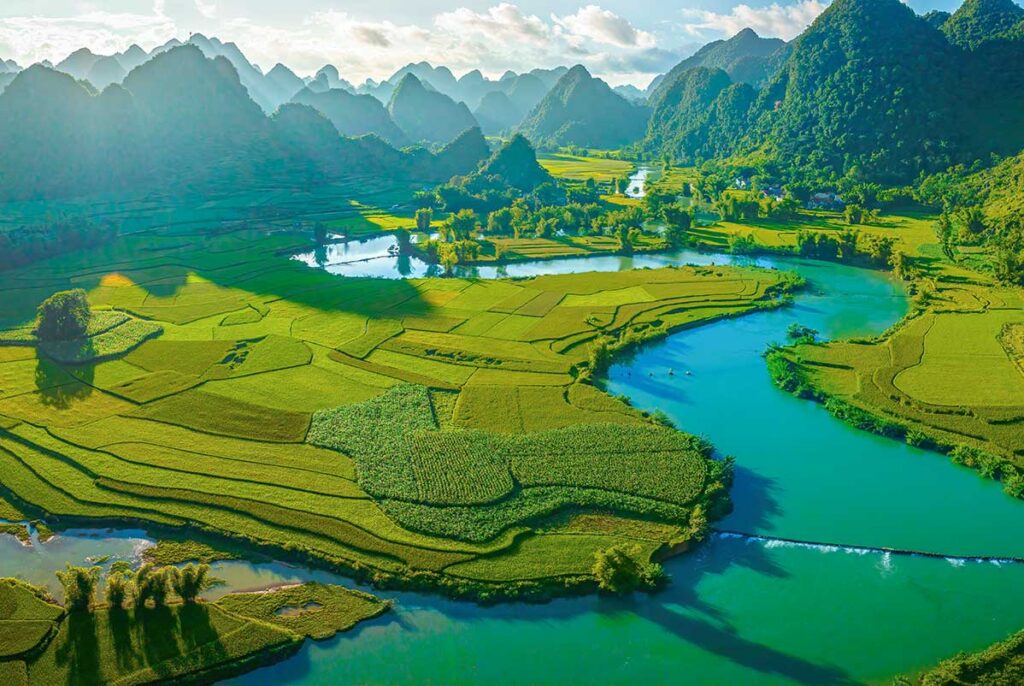
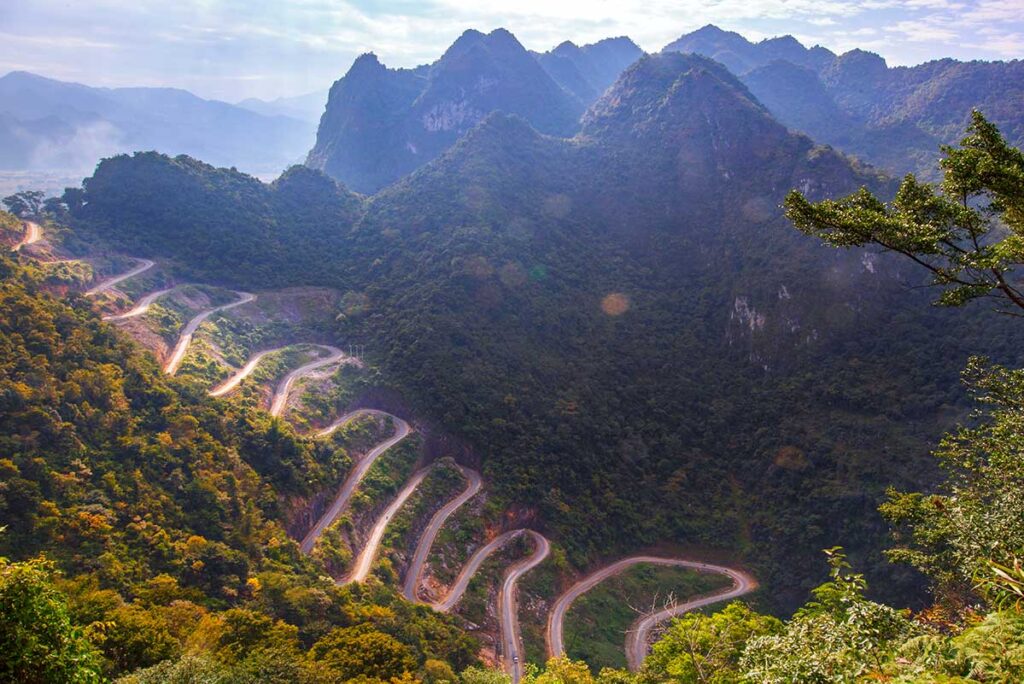
You’ll find remote valleys, ethnic minority villages, and rice fields in places like Bao Lac, Phong Nam Valley, and Angel Eye Mountain — some of the most breathtaking scenery in the country. Cao Bang is often seen as a quieter alternative to Ha Giang, offering the same dramatic views but with fewer visitors.
Best things to do in Cao Bang
Cao Bang is full of wild landscapes, ethnic culture, and hidden gems — far beyond what most travelers expect. While Ban Gioc Waterfall is the main draw, some of the best things to do in Cao Bang are found on the backroads, where you’ll pass through remote valleys, quiet villages, and dramatic limestone peaks. Whether you travel by car, motorbike, or guided tour, this province offers some of the most authentic and scenic experiences in northern Vietnam.
1. Visit Ban Gioc Waterfall
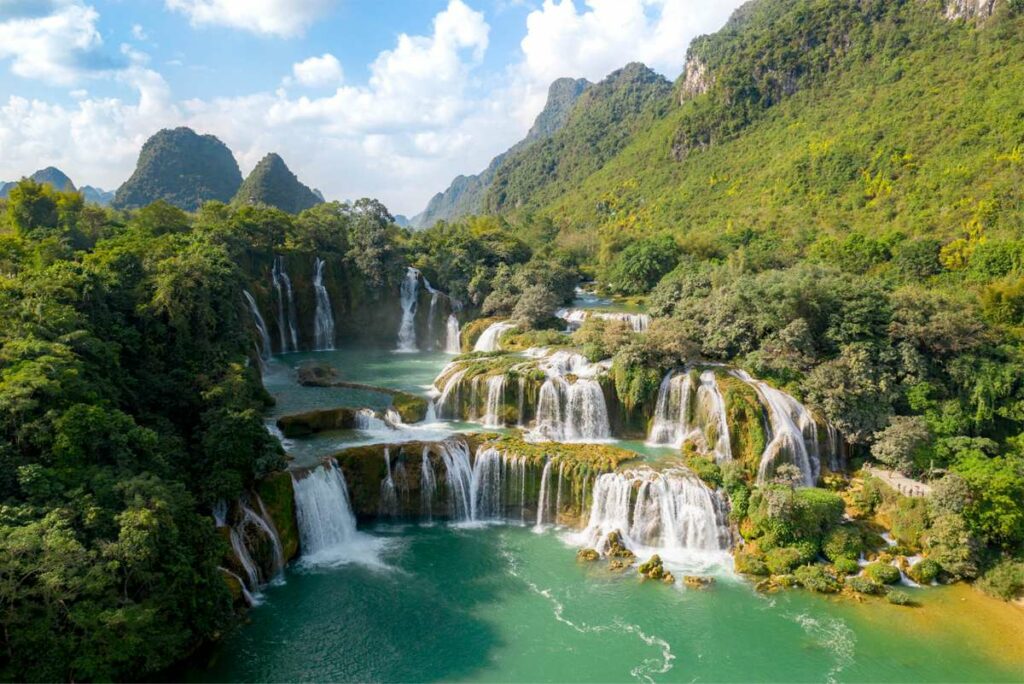
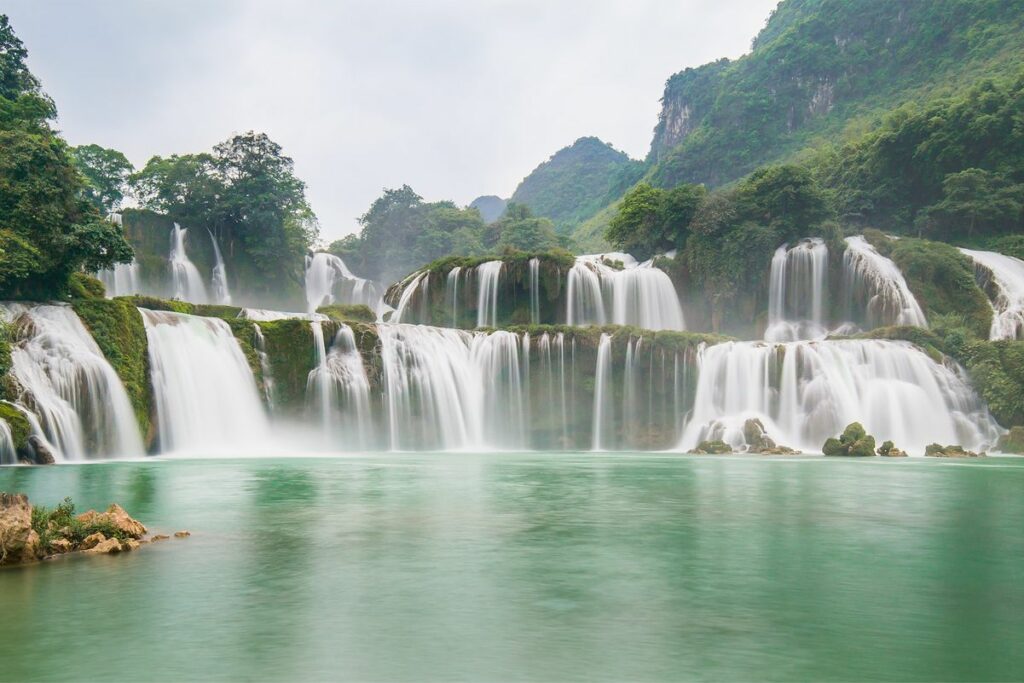
Ban Gioc Waterfall is not only the most famous attraction in Cao Bang, but also one of the most spectacular waterfalls in all of Vietnam. The wide, multi-tiered falls cascade down the Quay Son River, right on the border with China. Surrounded by karst mountains and rice fields, it’s an impressive natural sight, especially during the rainy season when the water is at its strongest.
You’ll pay a small entrance fee (around 2 USD) to access the area, and you can take a bamboo raft to get up close to the falls. The volume of water changes throughout the year — it’s most powerful from June to September and lower during the dry season. Just a few minutes before reaching the falls, you can also stop at Phat Tich Truc Lam Ban Gioc Pagoda, located on a hill above the valley. From the top, there’s a peaceful viewpoint overlooking part of the waterfall and the surrounding landscape — a good photo stop even if the full waterfall isn’t visible.
For details on how to get there and when to see the waterfall at its best, check our full Ban Gioc Waterfall guide.
Ban Gioc is best visited as part of a tour, combining the waterfall with nearby hidden gems. Tours by car, motorbike, or Easy Rider are available — all with transfers, routes, and local stops taken care of.
2. Phong Nam valley
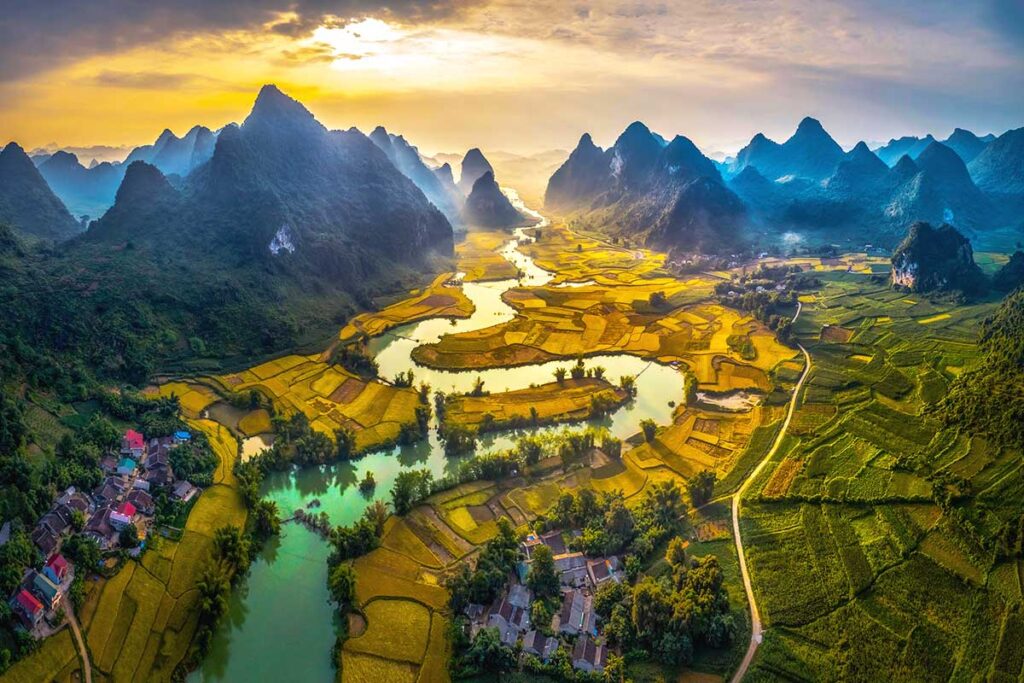
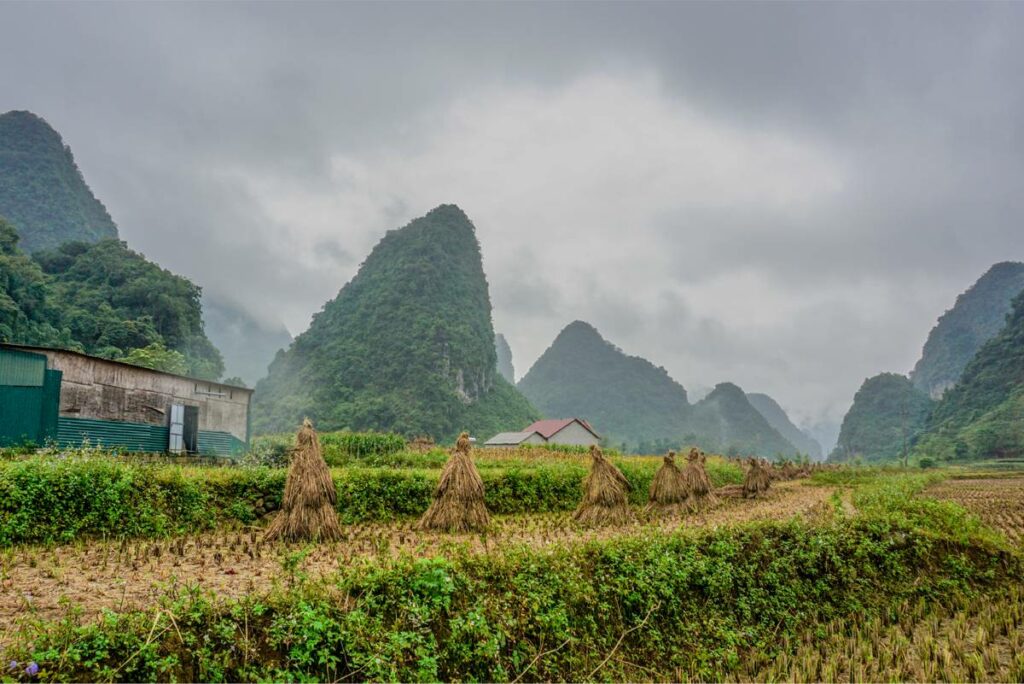
Phong Nam Valley is one of the most beautiful yet underrated things to do in Cao Bang. Located not far from Ban Gioc, this peaceful valley is lined with limestone cliffs, rice paddies, and scattered ethnic minority villages. It’s one of those rare places where you can drive for an hour and barely see another traveler — just slow rural life and stunning views.
It’s not a single attraction, but rather a scenic area to explore by road. You can get there by car or motorbike, but a motorbike makes it easier to access the narrower paths. There’s also a small hilltop viewpoint you can hike up for a wide view over the valley — the climb is short but steep, and well worth the effort.
Want to explore deeper? Read our full guide to Phong Nam Valley for tips on how to get there, where to go, and how to get around.
See tours that include a stop at Phong Nam Valley — often combined with Ban Gioc and nearby viewpoints.
3. Angel Eye Mountain
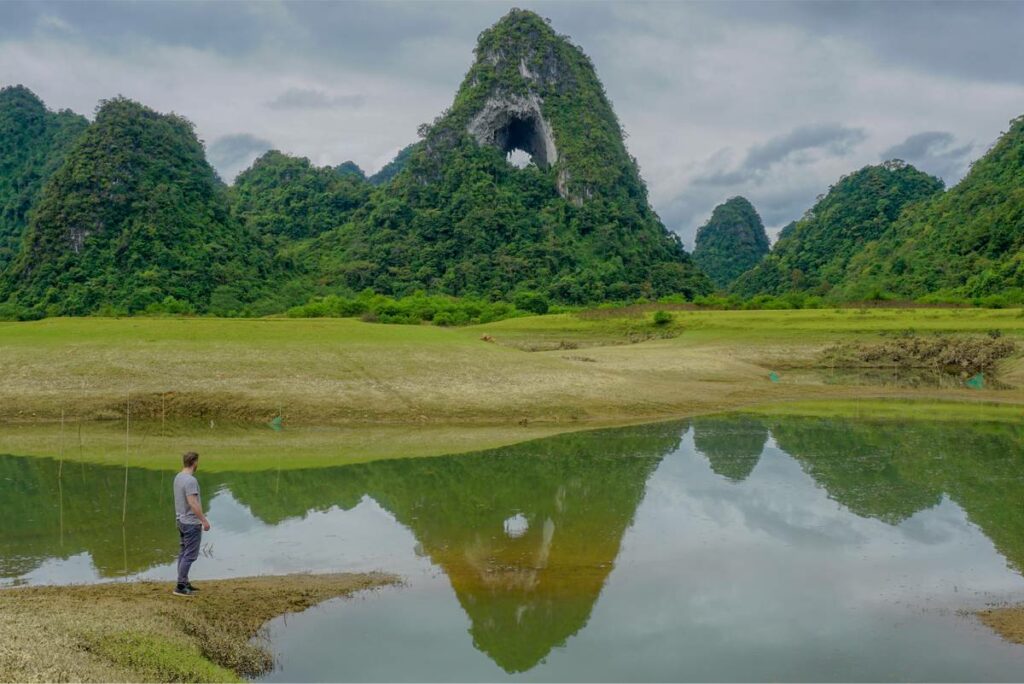
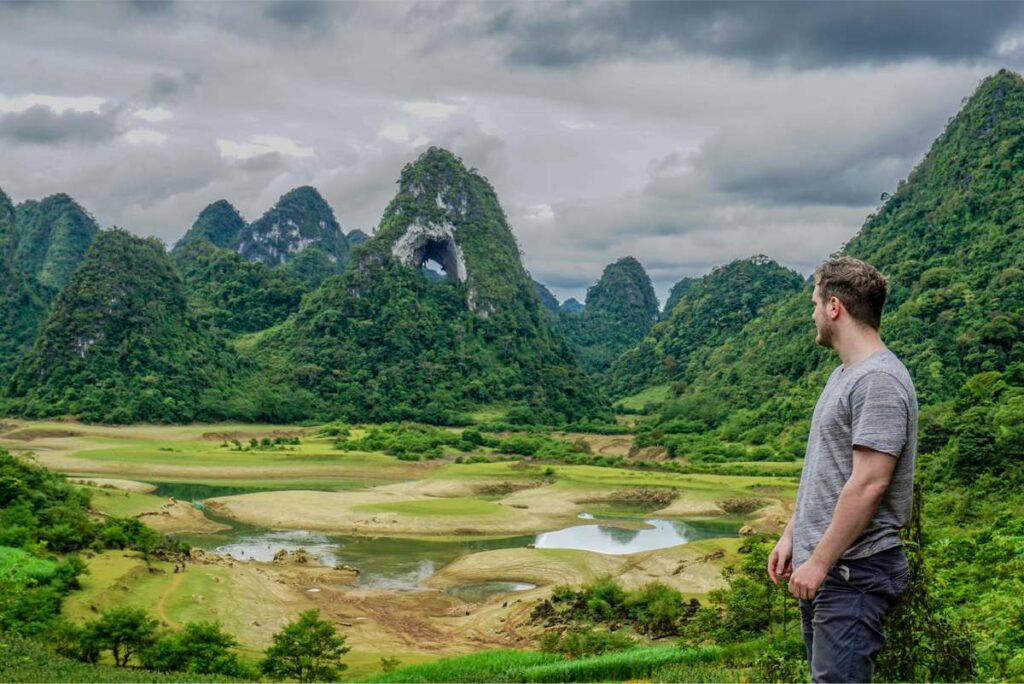
Angel Eye Mountain (Nui Thung Mountain) sits in the middle of a quiet, green valley surrounded by limestone cliffs. What makes it special is the giant circular hole through the mountain, resembling an eye. The area around it is just as impressive — open meadows, small streams, and stilt-house villages make this a peaceful, postcard-like spot.
It’s best visited on the way from Cao Bang city to Ban Gioc, with a short detour to reach the valley. There’s not much in terms of shops or restaurants, so bring your own snacks and water. It’s a great place for a picnic, and there’s even a small campsite and a local homestay nearby if you want to stay overnight — though most travelers visit it as a day stop.
See our complete Angel Eye Mountain guide for directions, nearby sights, and options for staying overnight in the area.
This stop is often included in off-the-beaten-track tours between Cao Bang and Ban Gioc, especially for those traveling by motorbike or private car.
4. Walk to the Me Pja Pass Viewpoint
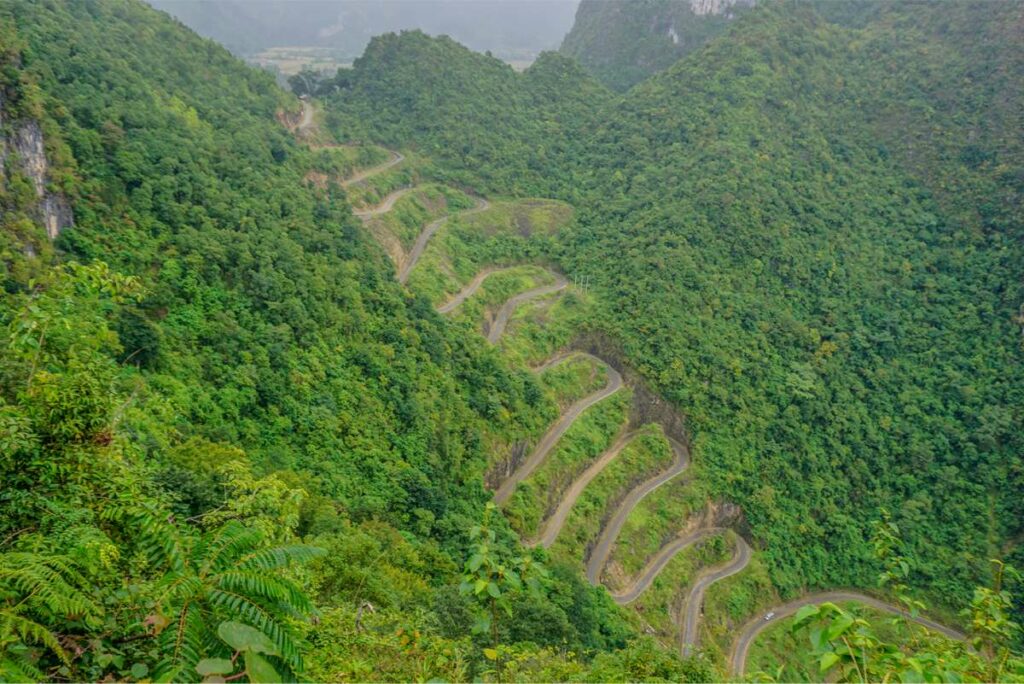
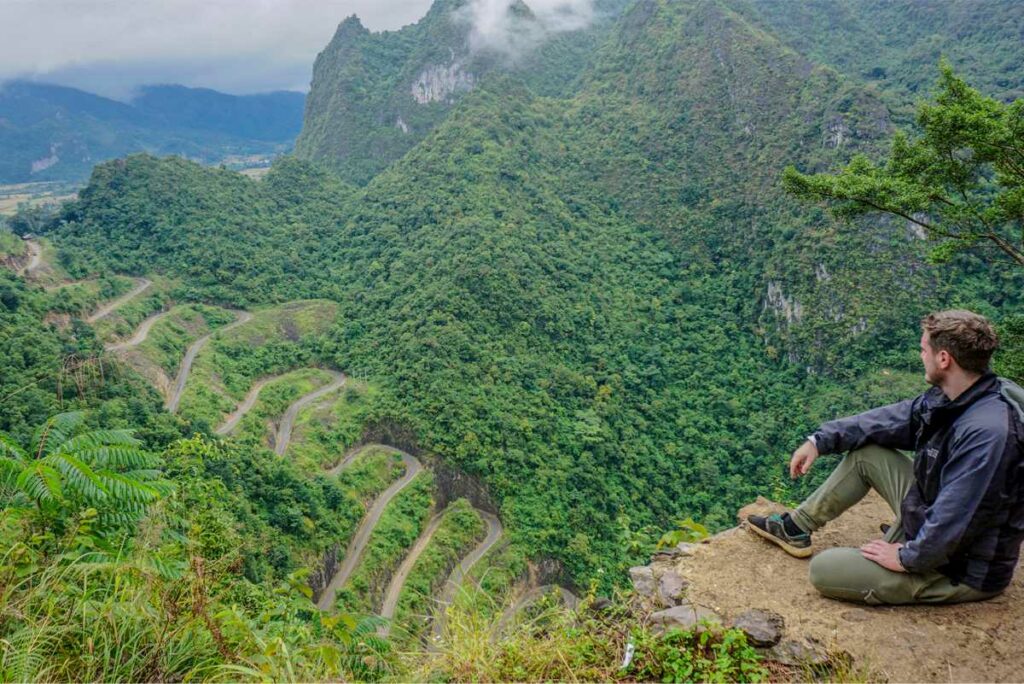
Me Pja Pass is a winding mountain pass in western Cao Bang, known for its signature snake-like curves and remote location. It’s far from the Ban Gioc side of the province, but worth the journey if you like dramatic landscapes without the crowds. While the road itself has some nice bends, the real highlight is the hidden viewpoint at the top — offering one of the most panoramic mountain views in northern Vietnam.
Driving the pass is enjoyable, but the scenery really opens up once you start walking. From the top of the pass, park your vehicle and look for a small trail — it’s not well-marked, but easy to find if you stop at the highest point of the road. The hike takes around an hour uphill, and while it’s a bit of a workout, the view over the surrounding valleys and mountains makes it one of the best things to do in Cao Bang for landscape lovers. Make sure to check the time before you start — you don’t want to hike or drive here after dark.
For directions, hiking tips, and what to expect at the top, see our full Me Pja Pass guide.
The full Cao Bang Loop tours — by car or motorbike — often include a stop at Me Pja Pass, especially for travelers exploring the more remote western districts.
5. Experience Local Life in Bao Lac
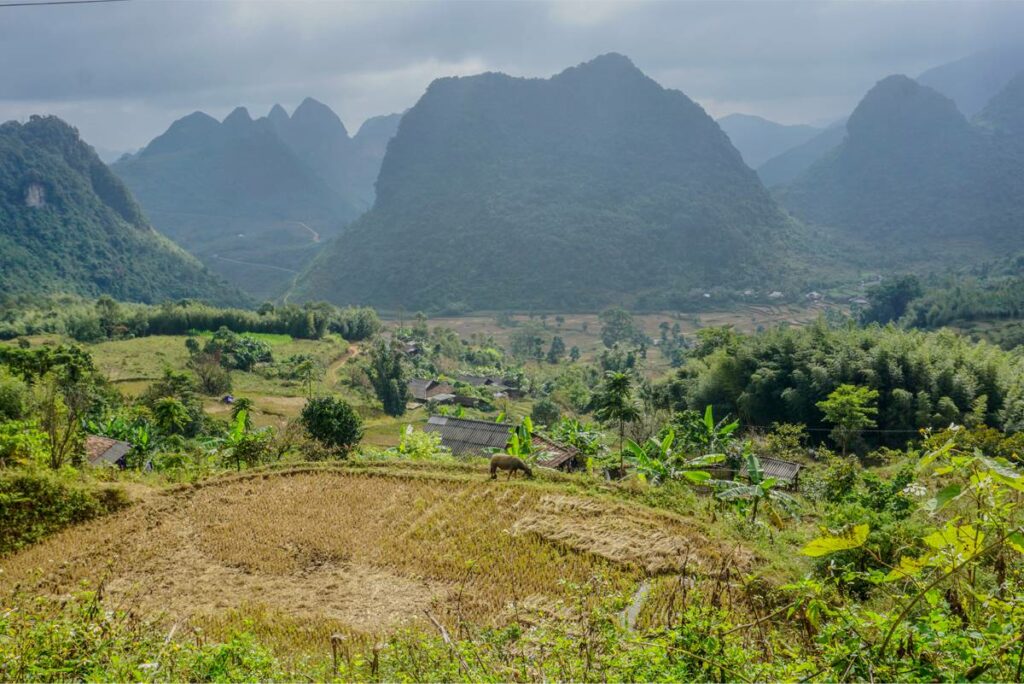
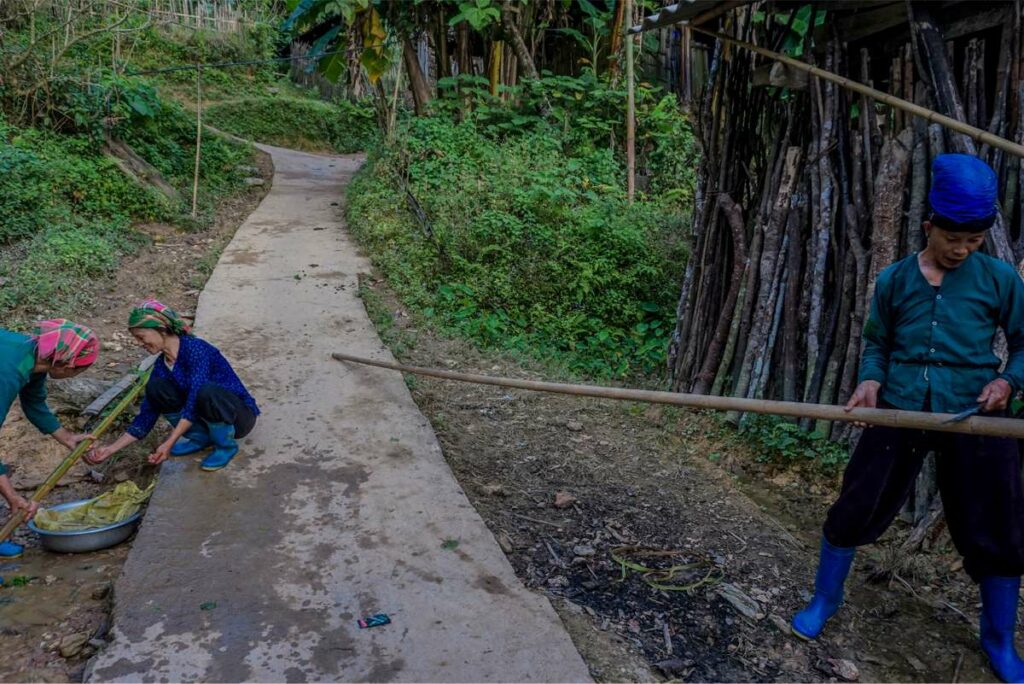
Bao Lac is a quiet district in western Cao Bang, far removed from the more visited Ban Gioc area. The landscape is just as stunning — with deep valleys, winding roads, and traditional stilt-house villages — but you’ll rarely see other travelers here. Both the district and its small main town offer a glimpse into local life, especially among ethnic groups like the Black Lô Lô, who live in nearby villages. The area also hosts a colorful market where people from surrounding mountain communities come to trade.
There are two main ways to visit Bao Lac. One is by doing the full Cao Bang Loop, which includes highlights like Ban Gioc, Angel Eye Mountain, and Phong Nam Valley — check our detailed Cao Bang Loop guide for the full route. The second option is to pass through when traveling between Ha Giang and Cao Bang, since Bao Lac borders Ha Giang province and makes a natural connection between the two loops.
For more on what to see and how to get there, read our full Bao Lac guide.
Check out our Ha Giang & Cao Bang combo tour and our 4-day Cao Bang Loop tour — both include a stop in Bao Lac.
6. Hike in Phia Oac – Phia Den National Park
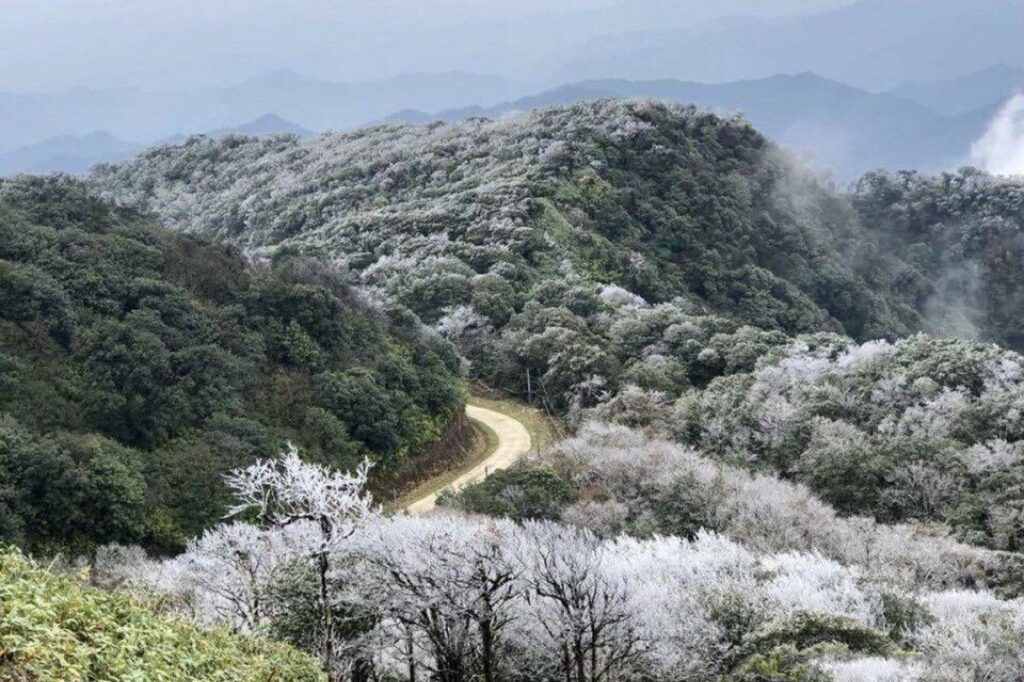
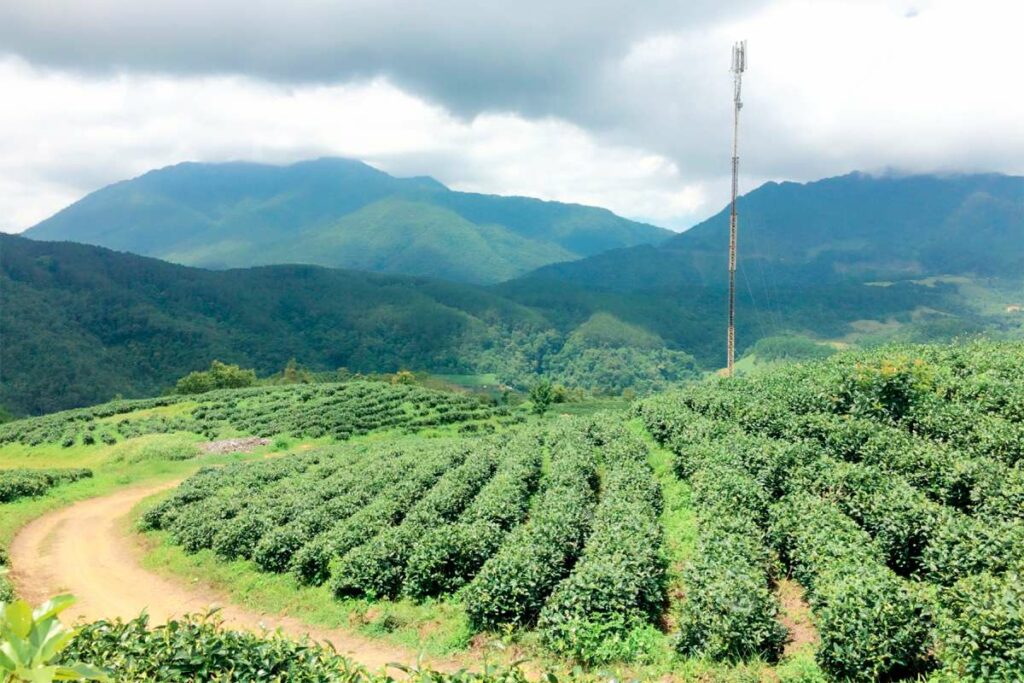
Phia Oac – Phia Den is a forested national park in a cooler part of Cao Bang, known for its mountain climate, hiking trails, and peaceful views. The area is often misty, with pine trees, mossy rocks, and viewpoints above the clouds — a completely different vibe from the rest of the province.
It’s quite far from other places in this list but can be added with a small detour when heading west toward Bao Lac or Me Pja Pass. There are a few homestays in the area, and it can get surprisingly cold here in winter — even snow is possible in rare cases. If you’re looking to escape the heat or enjoy a quiet forest walk, this is one of the best lesser-known things to do in Cao Bang.
Read our complete guide to Phia Oac – Phia Den for how to get there, where to stay, and what to do.
7. Visit Nguom Ngao Cave
Nguom Ngao is a limestone cave just a few kilometers from Ban Gioc Waterfall. The cave stretches over 2 km, with wide chambers, stalactites, and eerie rock formations lit by soft, colored lights. It’s not the most spectacular cave in Vietnam, but it’s cool, quiet, and makes for a pleasant change of pace from outdoor scenery.
Because of its location, it’s one of the easiest places to add to your Ban Gioc day. You only need about 30 minutes to explore it, making it a practical stop — especially on hot days or when you want to avoid rain. Paths are easy to walk, and the temperature inside is refreshing all year round.
See our full guide on Nguom Ngao Cave for how to visit and combine it with Ban Gioc Waterfall.
8. Experience ethnic cultures and hidden villages
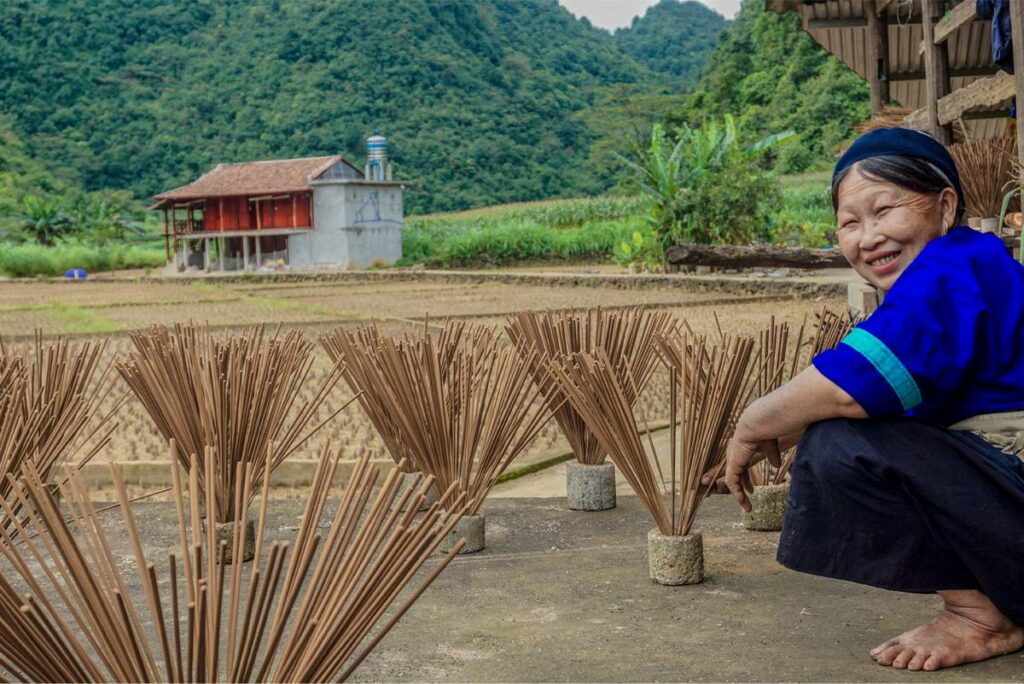
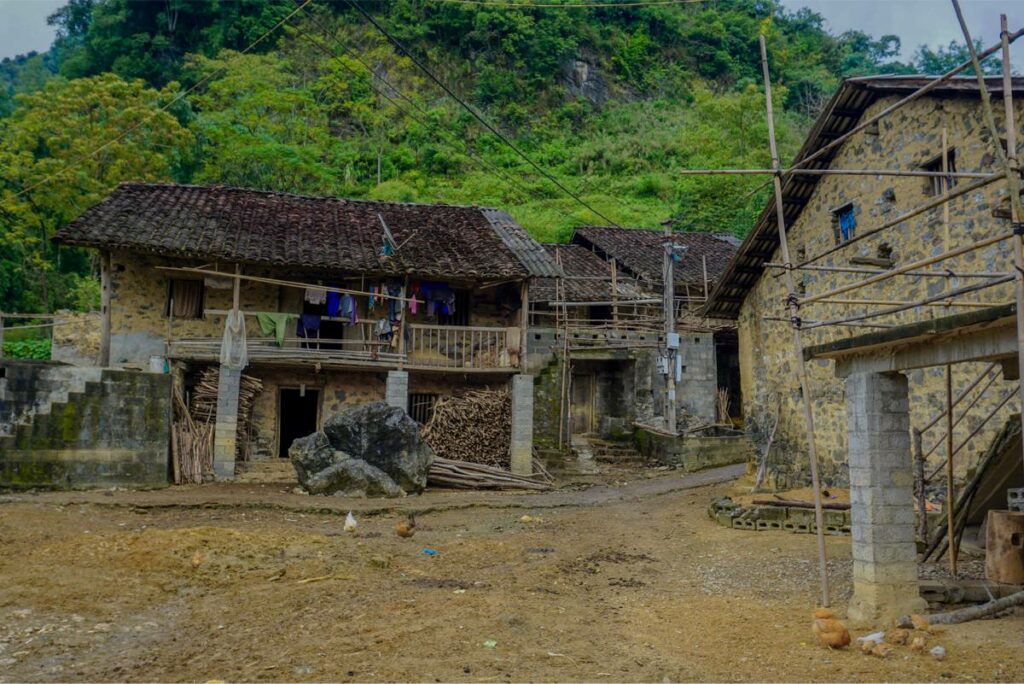
Thang Hen Lake is a peaceful lake surrounded by forested hills and seasonal rice fields, making it a relaxing spot for outdoor activities. The lake is clean and calm, great for swimming, picnicking, or just enjoying the quiet. You can also rent a paddleboard or take a small boat to a nearby cave on the lake’s edge.
There’s a small resort near the lake that now mainly functions as a ticket point, with a modest entrance fee. It’s easy to combine a visit here with nearby sights like Angel Eye Mountain. If you want a break from driving or sightseeing, this is a good place to slow down and cool off.
Read our guide to Thang Hen Lake for access details and what else to do nearby.
9. Trekking at Vinh Quy Grass Hill
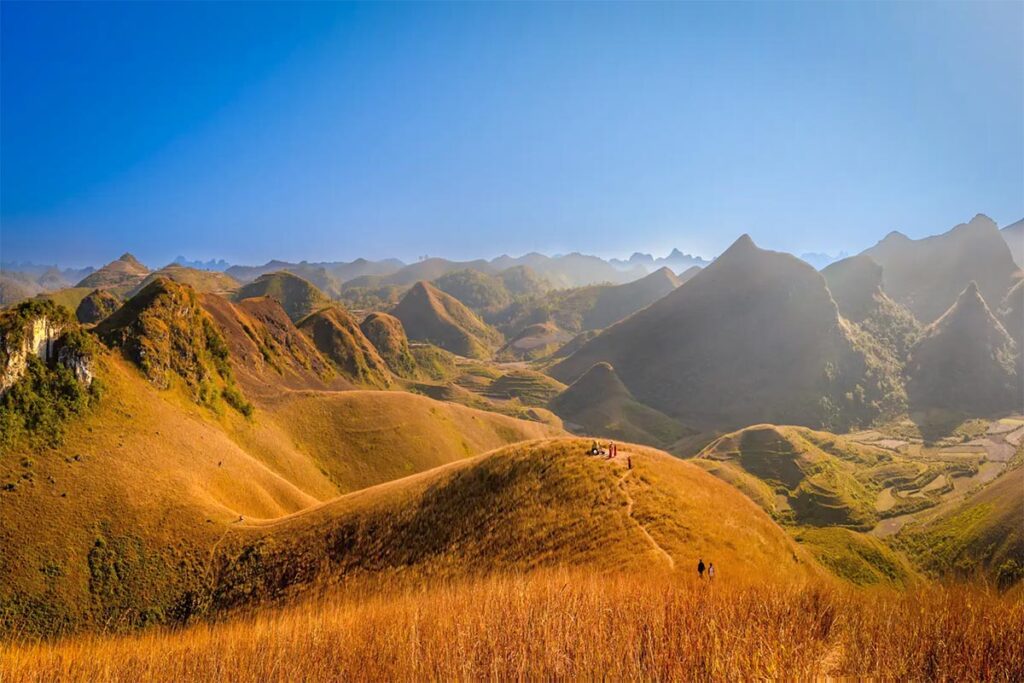
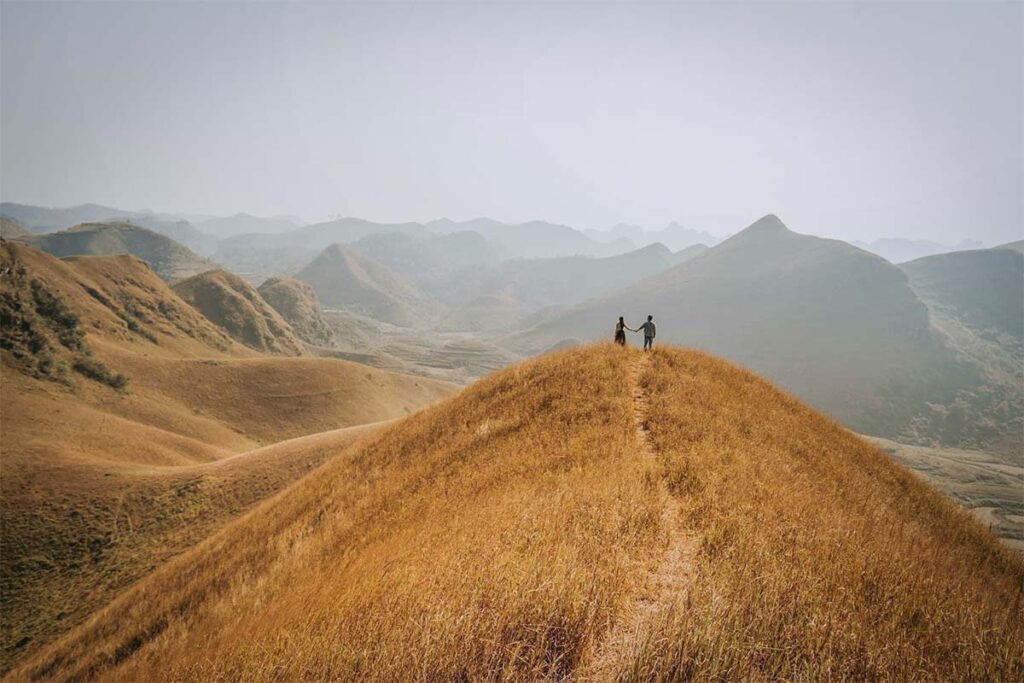
Vinh Quy Grass Hill is a lesser-known but scenic spot in the eastern part of Cao Bang. The area is made up of rolling green hills, scattered limestone peaks, and open landscapes that feel far removed from busy routes. It’s a great place for a short trek or just to enjoy the peaceful scenery — one of the more offbeat things to do in Cao Bang if you’re avoiding the main tourist routes.
It’s a bit out of the way but works well as part of a loop. Instead of returning the same way from Ban Gioc to Cao Bang, you can drive back via an eastern route that passes through Vinh Quy — also covering Phong Nam Valley and Angel Eye Mountain. The drive is slightly longer but more rewarding, especially if you want to avoid repeating the same road.
See our guide on how to reach Vinh Quy Grass Hill and what to combine it with.
10. Visit Pac Bo Historical Site
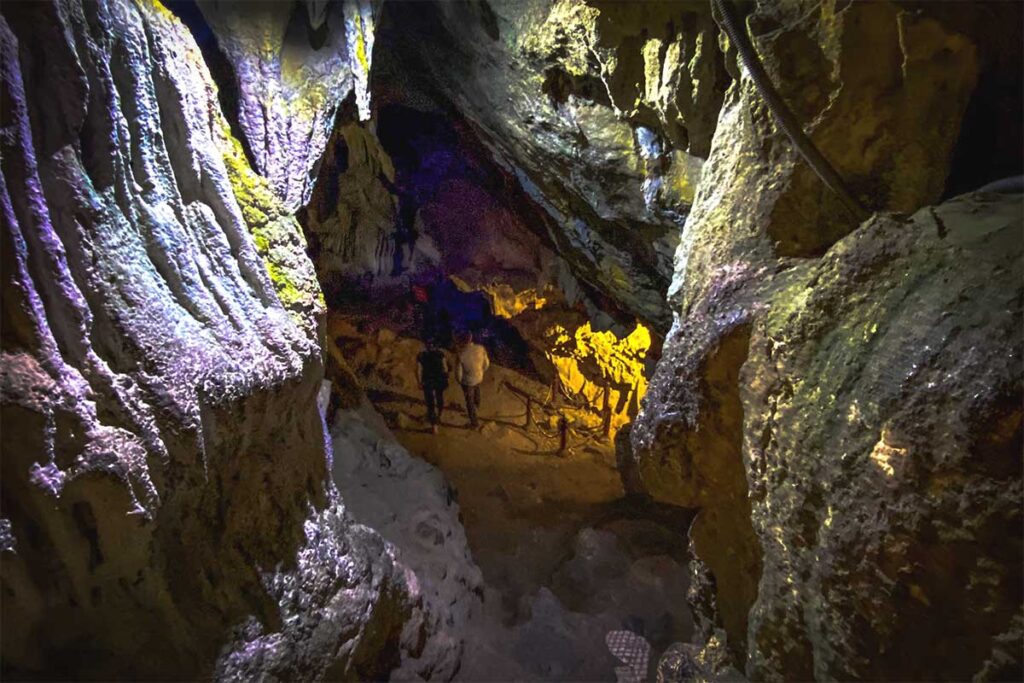
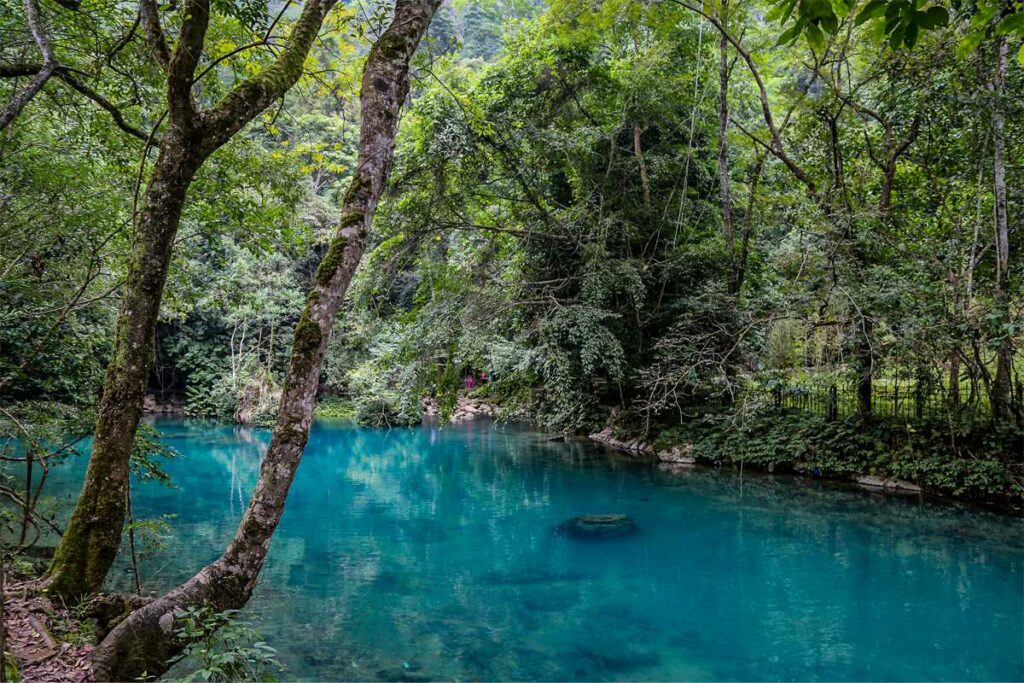
Pac Bo is a peaceful historical site located in the far north of Cao Bang, near the Chinese border. It’s where Ho Chi Minh secretly lived after returning to Vietnam in 1941, planning the resistance against French colonial rule. The site includes a small cave, a memorial area, and a stream named after Lenin — surrounded by lush, remote mountains.
It’s quite a drive from the city and other sights, so it’s best combined with a trip to the western region of Cao Bang. While it’s not one of the most famous tourist things to do in Cao Bang, the scenery on the way is beautiful, and the quiet atmosphere makes it feel like a hidden corner of Vietnamese history.
Check our full Pac Bo guide for how to get there and what you’ll see on arrival.
11. Swimming at Thang Hen Lake
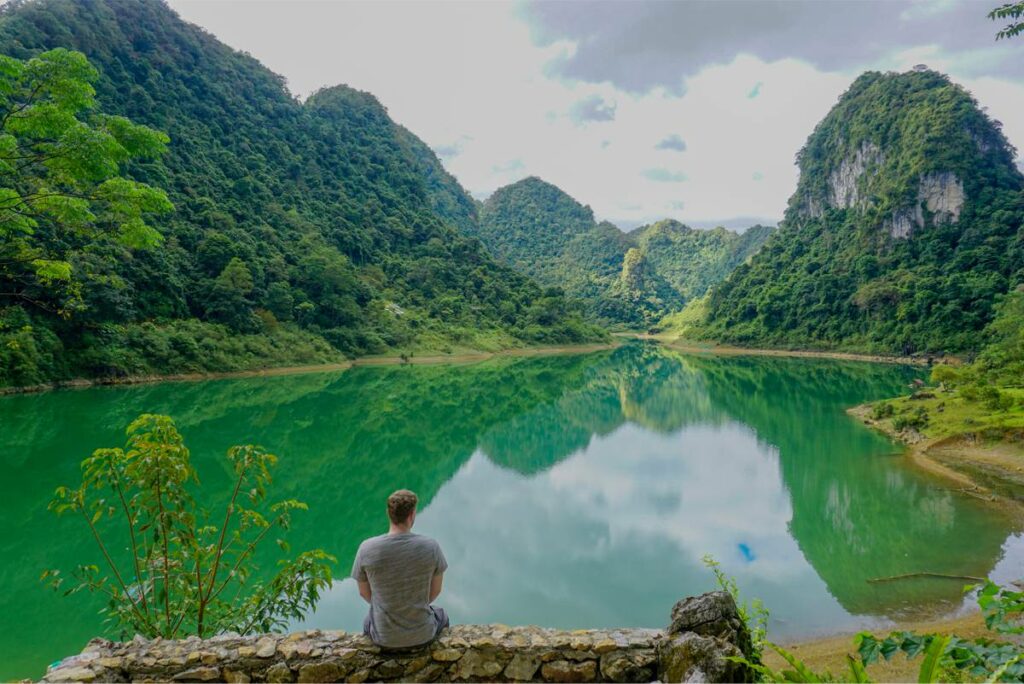
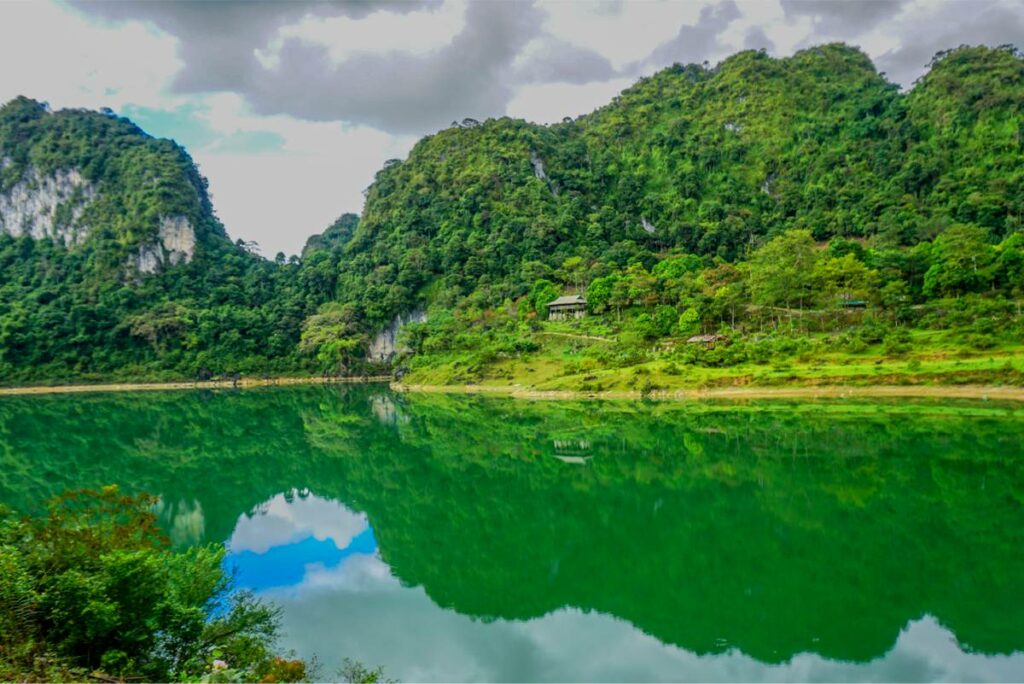
Phia Oac mountain range has the second highest peak in Cao Bang. The area is especially known for one of the only places in Vietnam where temperatures can plunge below zero with even snow and white frost. There is also a nice forest where you can wander around and the area is also known for its tea plantations.
Best time to visit Cao Bang
Cao Bang is a year-round destination, but the kind of experience you’ll have depends on the season. Each period brings its own atmosphere — from dry spring days to lush summer landscapes. Here’s a quick overview to help you decide:
- Spring (February–April): This is the most comfortable time weather-wise — mild temperatures, not too much rain, and good conditions for hiking. However, it’s still dry season, so Ban Gioc Waterfall has less water and the landscapes aren’t at their greenest.
- Summer (May–August): It’s warm and humid, but higher altitudes keep it more bearable than places like Hanoi. Expect short, heavy rain showers, often in the afternoon. The big draw is the scenery — rice fields are lush, and Ban Gioc is at its most powerful.
- Autumn (September–October): Arguably the best all-around time to visit. The weather is more stable, the rice fields are golden during harvest, and the views around valleys and waterfalls are still spectacular.
- Winter (November–January): Dry and cold, especially in the mountains. As long as you dress warmly, it’s still a great time for exploring. Ban Gioc can be underwhelming in the later winter months when water flow is at its lowest.
Want to see the best months specifically for Ban Gioc Waterfall? Check out our full month-by-month guide with seasonal travel tips for Cao Bang.
Where to stay in Cao Bang
Cao Bang isn’t a major tourist hub, which means accommodation here is generally simple and low-key. Most hotels and homestays are basic — don’t expect modern luxury — but that’s also part of the charm. Whether you stay in a small village or a local guesthouse, the hospitality is usually warm and authentic. Because Cao Bang is a large province, where you stay depends a lot on your route and timing.
Here are the main areas where travelers tend to stay:
1. Cao Bang City – For transit stops
Cao Bang city is the provincial capital, and while it’s not very atmospheric, it’s a practical stop. It’s a good place to spend the night if you arrive by bus in the late afternoon or need to catch one early the next day. Some travelers also stay here for a short break before heading to other regions, but it’s not ideal as a base to explore the best things to do in Cao Bang, since most highlights are located much further away.
Recommended stays in Cao Bang City:
- Jeanne Hotel – Centrally located, good service, modern feel.
- Max Boutique Hotel – Comfortable beds, stylish design, one of the better mid-range options.
2. Trung Khanh – For Ban Gioc & Surroundings
Trung Khanh district is where most of the best things to do in Cao Bang are found. It includes famous sights like Ban Gioc Waterfall, Nguom Ngao Cave, and scenic areas like Phong Nam Valley and Angel Eye Mountain. This makes it the most strategic area to stay if you’re here to explore Cao Bang’s highlights.
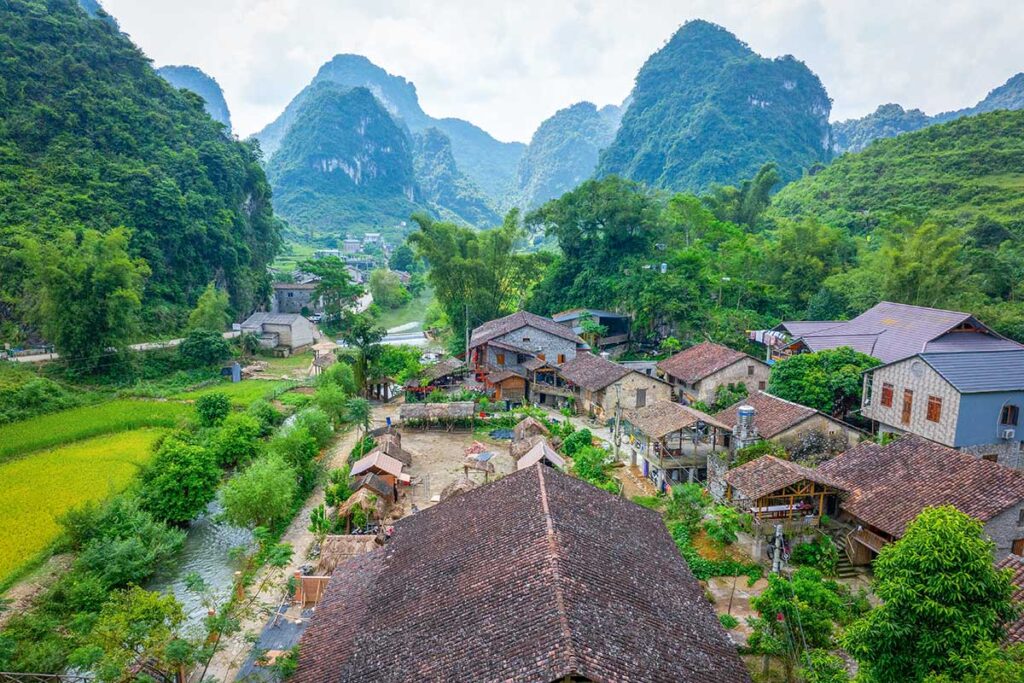
One of the more unique places is Khuoi Ky Stone Village, a small ethnic village where many traditional houses have been turned into homestays. The setting is beautiful, but accommodations are basic. Along the river in the same region, you’ll also find more spread-out homestays. A standout here is Lan Homestay — surrounded by limestone mountains and set right by the water.
3. Bao Lac – For Loop travelers & Ha Giang connections
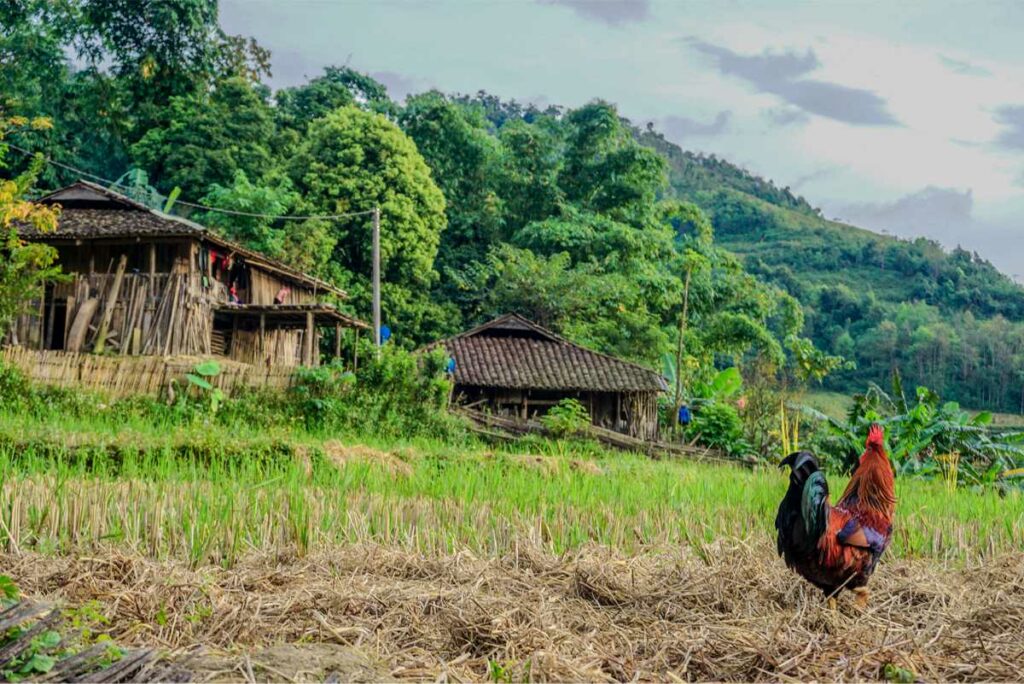
Bao Lac district is a useful overnight stop for those doing the full Cao Bang Loop or entering from Ha Giang. The town itself has a few modest guesthouses and homestays — nothing fancy, but fine for a short stay. A more special option is found just outside the town in Khuoi Khon Village, home to the Black Lô Lô ethnic group. The homestay here isn’t just a place to sleep — it’s a rare cultural experience in a beautiful mountain setting.
Recommended stay near Bao Lac:
- Khuoi Khon Homestay – Run by a local Black Lô Lô family, scenic and authentic, a bit out of the way but worth the detour.
4. Remote areas – For scenic stopovers
If your itinerary takes you through places like Angel Eye Mountain, Phia Oac – Phia Den National Park, or other remote corners of the province, you’ll find a few homestays and basic lodges scattered along the way. These areas aren’t typically used as travel bases, but they’re very useful for breaking up longer routes — and you’ll often get to enjoy nature without anyone else around.
Food & drinking
Eating in Cao Bang is a local experience — don’t expect trendy cafés or fancy Vietnamese restaurants. Most meals are simple, home-style, and part of the charm of traveling in a remote area.
No western food or fancy options
Cao Bang is not developed for tourism in the same way as places like Hanoi or Sapa. You won’t find pizza, Western breakfasts, or upscale Vietnamese cuisine. Most local eateries are small, informal places with plastic chairs and one-dish menus.
Homestay dinners are the norm
If you’re staying in a village or anywhere outside Cao Bang city, you’ll likely eat where you sleep. Homestay meals are usually cooked fresh with seasonal ingredients — expect rice, vegetables, local meats, and sometimes river fish. These shared dinners are also a nice way to connect with your hosts and learn more about their daily life.
Cao Bang specialty dishes
One of the most unique local dishes is bánh trứng kiến — a sticky rice cake filled with ant eggs, made by the Tay ethnic group. It’s a seasonal dish, so you won’t always find it, but worth trying if you get the chance. The region is also known for its roasted chestnuts, which are sold in roadside stalls and near Ban Gioc Waterfall.
How to get there
Cao Bang is far north and lacks transportation infrastructure. There are no train stations or airport. Even though there are plans to built an aiport in Cao Bang, for now the only way is by road.
Busses to Cao Bang
There are different bus companies driving between Hanoi and Cao Bang. There are both sleeper buses (at night) as comfortable mini buses during the day time. The ride from Hanoi to Cao Bang takes about 6 to 8 hours. Read full guide: How to get from Hanoi to Cao bang.
Cao Bang is not very well connected with other provinces and you might need to travel first back to Hanoi before continuing your trip to your next destination.
Private cars to Cao Bang
In addition to buses and mini vans you can also opt for a private car. A private car with driver gives you more freedom and opportunity to use it to explore the province.
How to get around
Cao Bang is a remote region with no public transport between sights. To explore the area properly, you’ll need to go by motorbike or car with driver.
- Motorbike (self-drive):
Rent in Cao Bang city. Best for flexible travel and scenic backroads like Phong Nam Valley and Angel Eye Mountain. Only recommended with a valid license and riding experience.
See our guide to renting and driving a motorbike in Cao Bang
- Easy Rider (on the back of a motorbike):
Ride with a local driver. Great for those who don’t want to drive but still want the full experience. Stops at hidden spots and viewpoints.
- Car with driver:
Comfortable for longer distances or small groups. Drivers usually don’t speak much English and don’t guide — unless booked as a tour with a guide-driver combo.
Tip: Get to and around Cao Bang in one package
Our Cao Bang tours include all transfers from Hanoi, plus private car or Easy Rider transport around the region. Includes major sights and hidden gems.
[View All Cao Bang Tours]
How to get from Cao Bang to Ban Gioc waterfalls
The only way to travel between Cao Bang city and Ban Gioc Waterfall independently is by local bus, motorbike, or private car.
- Private car (with driver):
The most comfortable option. You can arrange a fixed-price car for the trip, though the driver won’t act as a guide unless you book a guided tour package. - Local bus:
The cheapest option. There are local buses operating from Cao Bang city — check schedules at the bus station or your hotel for the most up-to-date times. Note: buses don’t stop at other sights, and language might be a barrier. - Motorbike rental:
Renting a motorbike lets you explore the beautiful area on your own. Best done over at least 2 days — a one-day round trip is long (7–8 hours) and suitable only for experienced riders with a valid license.
Itinerary 2 days in Cao Bang
Day 1
- Take the day before a night bus to Cao Bang City or a early morning mini bus the same day.
- From Cao Bang you driver via the Ma Phuc pass to Ban Gioc waterfall. On the way you can enjoy stunning landscapes.
- Visit the Ban Gioc waterfall. Wander around and take time to enjoy and make photos.
- After this you will visit the Ban Gioc pagoda.
- Next you explore the Ngao cave.
- Stay overnight close to Ban Gioc waterfall.
Day 2
- In the morning you will driver through the stunning landscapes of Phong Nam valley.
- Visit some local villages, such as Phia Thap incense village.
- Next you visit Thang Hen lake and Angel Eye mountain, before heading back to Cao Bang City where your 2 day Cao Bang trip ends.
Travel tips for Cao Bang
Planning a trip to Cao Bang? Here are some practical travel tips to help you prepare — from how many days to stay to what to pack and where to go next.
Recommended days to stay
If you only want to visit Ban Gioc Waterfall, Nguom Ngao Cave, and the pagoda, one day is technically enough. But Cao Bang has so much more to offer — hidden valleys, ethnic villages, and scenic mountain passes. For a proper experience, plan at least 3 days.
Cash & ATMs
You’ll find ATMs in Cao Bang City, but once you leave the city, cash is king. Most homestays, local restaurants, and shops do not accept cards. Bring enough cash for your entire stay outside the city.
Internet & Navigation
Buy a Vietnamese SIM card with data for easier communication and navigation. However, expect poor or no signal in remote areas. Download offline maps in advance (e.g., Google Maps or Maps.me) — they’ll be a lifesaver on backroads.
How to dress & What to pack
Cao Bang’s weather varies by season — hot and humid in summer, cold in winter, especially in the mountains. Pack accordingly, including a light rain jacket in the wet season.
If you plan to visit religious sites like Ban Gioc Pagoda or local villages, dress modestly (cover shoulders and knees).
Most viewpoints involve short hikes or rocky trails, so bring sturdy walking shoes.
Cao Bang with kids
Cao Bang is peaceful and low-traffic, making it safe to travel with children. The main challenge is the long driving times between sights — plan slow travel days and stay overnight near major highlights.
Local events & festivals
- Ban Gioc Waterfall Festival (October): Traditional games, cultural performances, and a water procession ceremony. If you’re visiting in autumn, it’s a great time to experience local traditions.
Where to go next?
Cao Bang pairs well with two other scenic destinations in northern Vietnam: Ba Be Lake and Ha Giang. Both routes are remote and not connected by public transport — the only way to travel between them is by motorbike or private car.
- Ba Be Lake is located between Cao Bang and Hanoi and is known for peaceful boat trips, jungle landscapes, and caves.
- Ha Giang lies to the west of Cao Bang and is famous for its rugged mountains and ethnic villages along the Ha Giang Loop.
If you want to combine these regions, the easiest way is to book a multi-day tour that includes all transport, accommodation, and local highlights.
Check out our Cao Bang & Ba Be Lake tour and our Ha Giang & Cao Bang combo tour.
